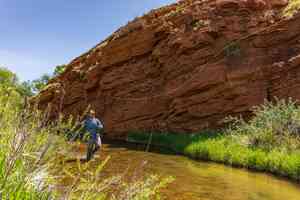The difficulty of attempting to undo over a century of human habitat modification is becoming increasingly clear. Complications continue to mount as the dam removal and habitat restoration project, which began last September, attempts to move forward on Washington's Elwha River. According to a report in northwest Washington's Peninsula Daily News, hundreds of dead chinook salmon smolts were found on the river's lower banks after last week's release of almost 200,000 juvenile fish from a hatchery several miles upstream.
According to a biologist that examined many of the dead fish, most of the fish had their gills clogged by sediment from the river, which resulted in the fish suffocating due to an inability to take up oxygen. Staff from the hatchery confirmed that they believed the dead fish were released from the hatchery. Biologists have since called the hatchery release a mistake and stated that they felt the survival rates of the recently released salmon would be "very low". With 900,000 more chinook due to be released by June, hatchery and Fish and Wildlife staff are exploring alternative release methods and sites to avoid a similar result.
The existence and timing of hatchery operations on the Elwha have been a subject of controversy since the inception of the removal project.
This latest complication comes on the heels of recent news that additional delays are expected in resuming the removal of the Glines Canyon Dam. Work on removal of that dam has been halted since last October, when sediment and trapped leaves, twigs and other organic matter clogged the intake of the $70 million water treatment plant that was constructed as part of the Elwha River restoration project. Officials are now stating that the project will be delayed until at least July, as $1.4 million in retrofits to the treatment facility are completed, though they estimate that work to remove the dam is still expected to be completed within the originally allotted 2 year time span.
In mid-March, scientists reported the discovery of increased and unexpected levels of sediment load in the Elwha. According to an article published last month in the Seattle Times, scientists are estimating that the sediment lode trapped behind the now fully removed Elwha Dam and the two-thirds removed Glines Canyon Dam is about 40 percent greater than previously estimated. According to the National Park Service, the now estimated lode of 34 million cubic tons, if spread onto a football field would create a tower that stretched 5.5 miles into the sky.
Scientists, official and volunteers involved in the Elwha dam removal and restoration project continue to relate dramatic and unexpected results which, given the size and scope of the operation, should likely be expected. Despite complications and delays with completing dam removal, the Elwha continues the work of habitat restoration on its own as it works on transporting a century of trapped silt, leaves, twigs, tree branches, tree stumps and more down river and eventually to the Pacific Ocean, with much unknown about what is still to come.































Comments